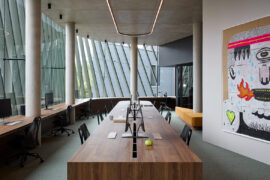Will the seismic shifts in consumer buying and digitalisation of shopping render brick-and-mortar shops obsolete? Maybe not. But they will make IoT and edge computing in the retail scene essential. Kevin Brown of Schneider Electric writes.

March 15th, 2018
One thing we all have in common is that we shop. Some of us routinely order groceries online while others try on diamonds at Tiffany’s or test drive sports cars at dealerships. Whether a chore or a splurge, shopping is a fact of life. So, we all have our own personal vantage point from which to view the seismic shifts that are taking place in the retail industry through the digitalisation of shopping and changes in buying behaviour.
Every day, we hear of established retailers shuttering stores and others filing for bankruptcy. Nine thousand stores closed in the United States in 2017, and a record 12,000 are expected to close this year.
Touted as the store of the future, Amazon’s new convenience market opened recently in Seattle and Amazon Go was newsworthy for what it didn’t have: lines of impatient shoppers, checkout counters, or cashiers waiting to tally your items.
It’s no surprise that Amazon, an online retailer that prides itself on offering the earth’s largest selection of everything, has harnessed technology to make check out a thing of the past. Instead, an app charges customers when they leave. For many customers, speed and convenience are the point. The app tells them exactly how long they visited the store. A customer can enter, grab lunch, and leave in less than a minute.
One such company is Rent the Runway, an e-commerce brand where customers rent designer dresses. Rent the Runway was founded in 2009, and after building a strong online presence, it opened showrooms, which have been described as dream closets, in a handful of United States cities starting in 2013. The stores feature check-in kiosks so store associates know the online interests of customers, and stores offer personal stylists, a further differentiation from traditional retail stores.
I believe this trend is evidence that consumers crave retail shopping experiences because, in person, you get to see the merchandise, you can touch the fabric, compare one product to another in a tangible way, make it social by shopping with friends, and those aspects of shopping get lost online with the focus on speed and convenience.
“Everyone was going to stay home, microwave bags of popcorn, and watch DVDs in the comfort of their own four walls!” Instead, we witnessed many multiplexes transform themselves by installing bars and comfortable furniture. Instead of getting popcorn at the snack counter, moviegoers could order appetizers to be conveniently delivered to their seats while they watched the film.
In the same transformational way, I believe the future will hold a mixture of online shopping and shopping at physical locations but the two will continue to become more tightly interconnected. Brick and mortar shops, where the overwhelming majority of goods are purchased, will be using more technology than ever, such as virtual dressing rooms where you can try on clothing without the hassle of getting undressed.
A colleague recently experienced this embrace of technology by retailers when she went shopping for a TV. She saw the model she wanted, compared it to others, and heard all about its benefits, only to learn it was sold out. The clerk suggested she order it from the retailer on her phone. So, instead of waiting in a long checkout line and dragging an enormous box to her car in the hope that it would actually fit in her car, the TV was delivered to her home. Now that’s convenience.
Therefore, edge computing will continue to become even more critical to the overall data centre solution. To manage these expectations, we need to think broader and embrace the complex data centre ecosystem of cloud, regional, and edge computing, and invest in solutions for a more resilient edge.
The digital transformation is happening to industries across the board but retail is one industry where all of us can see the changes as they are happening, especially when we visit our favourite store only to discover it has shut its doors for good.
INDESIGN is on instagram
Follow @indesignlive
A searchable and comprehensive guide for specifying leading products and their suppliers
Keep up to date with the latest and greatest from our industry BFF's!

Welcomed to the Australian design scene in 2024, Kokuyo is set to redefine collaboration, bringing its unique blend of colour and function to individuals and corporations, designed to be used Any Way!
The new range features slabs with warm, earthy palettes that lend a sense of organic luxury to every space.

From Australian architects to Spanish and Indian designers, Design Mumbai 2025 expands its international reach — proving India’s growing role on the global design stage.

GEYER VALMONT is launching an innovation hub designed to improve existing interior design capability through enhanced ways of working and industry-leading technology products.
The internet never sleeps! Here's the stuff you might have missed

Smart Design Studio and Those Architects combine landmark and workplace in Bundarra, a Surry Hills gateway blending old and new.

Sydney Open invites the public to explore over 55 buildings, spaces and new additions to the skyline, with a newly released Talks & Tours program offering direct access to the architects behind Bundarra and Pier Pavilion.